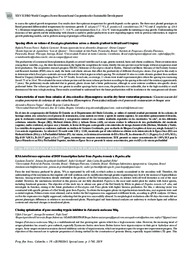RNA interference supression of DOF transcription factor from Populus tremula x Populus alba.
RNA interference supression of DOF transcription factor from Populus tremula x Populus alba.
Autoria: ZANELLA, L.; DEGENHARDT-GOLDBACH, J.; GERHARDT, I. R.; BESPALHOK FILHO, J. C.
Resumo: From the total biomass produced by plants, 70% is represented by cell wall, in which carbon is mainly accumulated in the secondary wall. Therefore, the understanding of the mechanisms that regulate cell wall synthesis and its modification through genetic engineering may lead to the increase of lignocellulosic biomass. Among several functions already attributed to the proteins of the Dof transcription factors, its relation with cell wall formation is one of the most studied. However, the mechanisms involved in this process are not fully elucidated. Populus is the most used model plant for studies with forest species, including functional genomics. The objective of this work was to silence one gene of the Dof family by RNAi in plants of Populus tremula x P. alba, and investigate its function, aiming at the future production of Eucalyptus and Pinus plants with higher biomass production. For this, a silencing vector was constructed with specific primers of a Dof family gene from Populus. To obtain the transgenic plants via Agrobacterium tumefaciens, root segments were used as initial explants. Fifteen events were obtained, and in twelve the Dof expression was suppressed at different levels, according to qPCR analyzes. Of these, on five the expression was highly suppressed, indicating that the gene was successfully silenced. In morphological evaluations after 90 days the events did not present phenotypic differences in relation to non transformed plants. Physiological and histochemical analyzes are underway to evaluate lignin and cellulose contents and structural changes in transformed plants.
Ano de publicação: 2019
Tipo de publicação: Resumo em anais e proceedings
Unidade: Embrapa Florestas
Palavras-chave: Populus alba, Populus tremula
Observações
1 - Por padrão são exibidas publicações dos últimos 20 anos. Para encontrar publicações mais antigas, configure o filtro ano de publicação, colocando o ano a partir do qual você deseja encontrar publicações. O filtro está na coluna da esquerda na busca acima.
2 - Para ler algumas publicações da Embrapa (apenas as que estão em formato ePub), é necessário ter, no celular ou computador, um desses softwares gratuitos. Sistemas Android: Google Play Livros; IOS: iBooks; Windows e Linux: software Calibre.
Acesse outras publicações
Acesse a Base de Dados da Pesquisa Agropecuária (BDPA) para consultar o acervo completo das bibliotecas da Embrapa.

